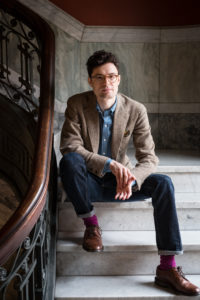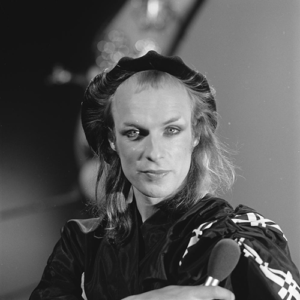On January 4, 5 and 6, conductor and pianist Jeffrey Kahane returns to the Houston Symphony for a program of classical pieces inspired by jazz and popular music, including Timo Andres’ Paraphrase on Themes of Brian Eno. In this post, discover how Andres transforms Eno’s late-’70s alt-rock melodies into a piece of orchestral music. Get tickets and more information here.

Born in California and raised in Connecticut, Timo Andres is one of the United States’ most successful young composers. In recent years he has received commissions from the Boston Symphony, the St. Paul Chamber Orchestra, Carnegie Hall and the New World Symphony among others. Andres composed his Paraphrase on Themes of Brian Eno during the winter of 2010, and the work was premiered in May of the same year in New York by the Metropolis Ensemble, a group with which the composer has maintained a close connection (you can listen to the Metropolis Ensemble’s recording of the Paraphrase here).
This piece is an homage to Brian Eno, the versatile British musician and producer who emerged from the glam rock movement of the late 1970s to become a pioneer of ambient music. With its trance-like atmosphere and experimental, often heavily processed sounds, Eno’s music has proved highly influential in the worlds of popular music and film, and it bears some interesting similarities with minimalism and post-minimalism in classical music, styles out of which Andres’ personal voice emerges. In his own program note for his Paraphrase, Andres wrote of Eno: “I think of him as a major composer, one with two quite distinct sides: as an innovator who works in ambient and collage music, and as a quirky and crafty pop songwriter. It’s all interesting, but the really amazing things happen when these musical personalities overlap and wear away each other’s surfaces.”

The Paraphrase is essentially an orchestration of several melodies from Eno’s alt-rock records of the late 1970s. Andres compares his work to “a 19th-century style ‘orchestral paraphrase,’” referring to a genre of light music that draws on preexisting material. Liszt, for instance, was famous for his virtuoso piano paraphrases of tunes from popular operas such as Rigoletto, Don Giovanni and Lucia di Lammermoor. For Liszt, the opera melodies provided opportunities to show off his astounding piano technique while drawing the audience in with easily recognizable tunes. Andres seems more interested in translating the sounds of Eno’s heavily processed, electronic rock band into acoustic, orchestral ones, and it is interesting to compare Andres’ treatment of the themes with Eno’s originals.
Before and After Andres
According to Andres, the Paraphrase focuses “on the albums Before and After Science and Another Green World, with some Apollo by means of an introduction.” Originally released in 1983, Apollo is an album that contains the tracks Eno created to accompany NASA footage of the Apollo 11 mission to the moon. Regarding his inspiration for the Paraphrase, Andres wrote, “When Andrew Cyr [the conductor of the Metropolis Ensemble] asked me to write some music to pair with my piano concerto, Home Stretch, I immediately thought of the spacious, static opening section of the piece and the huge debt it owes to Eno’s harmonies and timbres.” It is difficult to match the opening of the Paraphrase to a specific theme from Apollo, in part because the music of Apollo is generally more ambient than melodic. Andres’ string glissandos, steelpan (also known as the steel drum) and piano (with some notes muted by placing objects inside the instrument) do seem to correspond with many of the sounds of the album’s opening track, “Under Stars.”
The first true melody comes from the song “Everything Merges with the Night” from Eno’s 1975 album Another Green World. Throughout the Paraphrase, Andres selects melodies with similar shapes to create a sense of musical coherence, and chooses to focus on the dreamy, gently melancholy themes that seem most characteristic of Eno. In “Everything Merges with the Night,” the vocalist (Eno) sings to Rosalie while standing on a beach, possibly in Santiago, Chile. Eno’s lyrics, however, must be taken with a grain of salt, as he usually came up with the sounds (vowels and consonants) that musically made sense first and then retroactively fit words to them. Still, the words cannot be ignored completely, and Eno’s imagery tends to be highly evocative of the mood of his music. Andres gives the strumming guitar accompaniment to the piano and pizzicato cellos, while Eno’s vocal line goes to the bassoons. The characteristic piano countermelody begins in the same instrument, but soon transitions to the flutes and oboes.
A transitional passage then leads to the next Eno melody, “Julie With…” from the 1977 album Before and After Science. The singer is “on an open sea/Just drifting as the hours go slowly by” accompanied by Julie. In Andres’ version, the vocal line first appears in the flute doubled an octave below by a solo cello. When the texture thickens, real strings naturally replace the synthesized ones from Eno’s album.
Continuous piano arpeggios lead to the appearance of “Spirits Drifting,” the final track of Another Green World. This instrumental track features dense, nebulous textures and dissonances, which Andres scores for strings interwoven with tremolo flute and steelpan. The last Eno tune is “By this River” from Before and After Science. Full of detached resignation, Eno addresses an unnamed listener: “Here we are/Stuck by this river/You and I/Underneath a sky that’s ever falling down, down, down…” In the Paraphrase, the song’s instrumental countermelody appears first in the steel pan, followed by the vocal line in the oboe and horn. Andres’ orchestration and the addition of a flowing arpeggio accompaniment seem to brighten the mood of the original somewhat, and after a swell, the full orchestra plays a glittering version of the theme with glockenspiel. This dies away to a brief coda, which contains fragmentary ideas from the previous themes, ending with the motif that began “Everything Merges with the Night.”
Don’t miss Timo Andres’ Paraphrase on Themes of Brian Eno on January 4, 5 and 6, 2019! Get tickets and more information at houstonsymphony.org.



